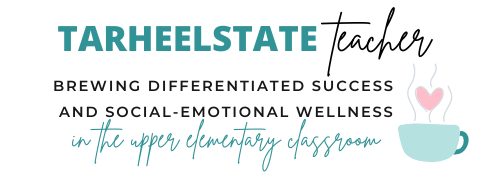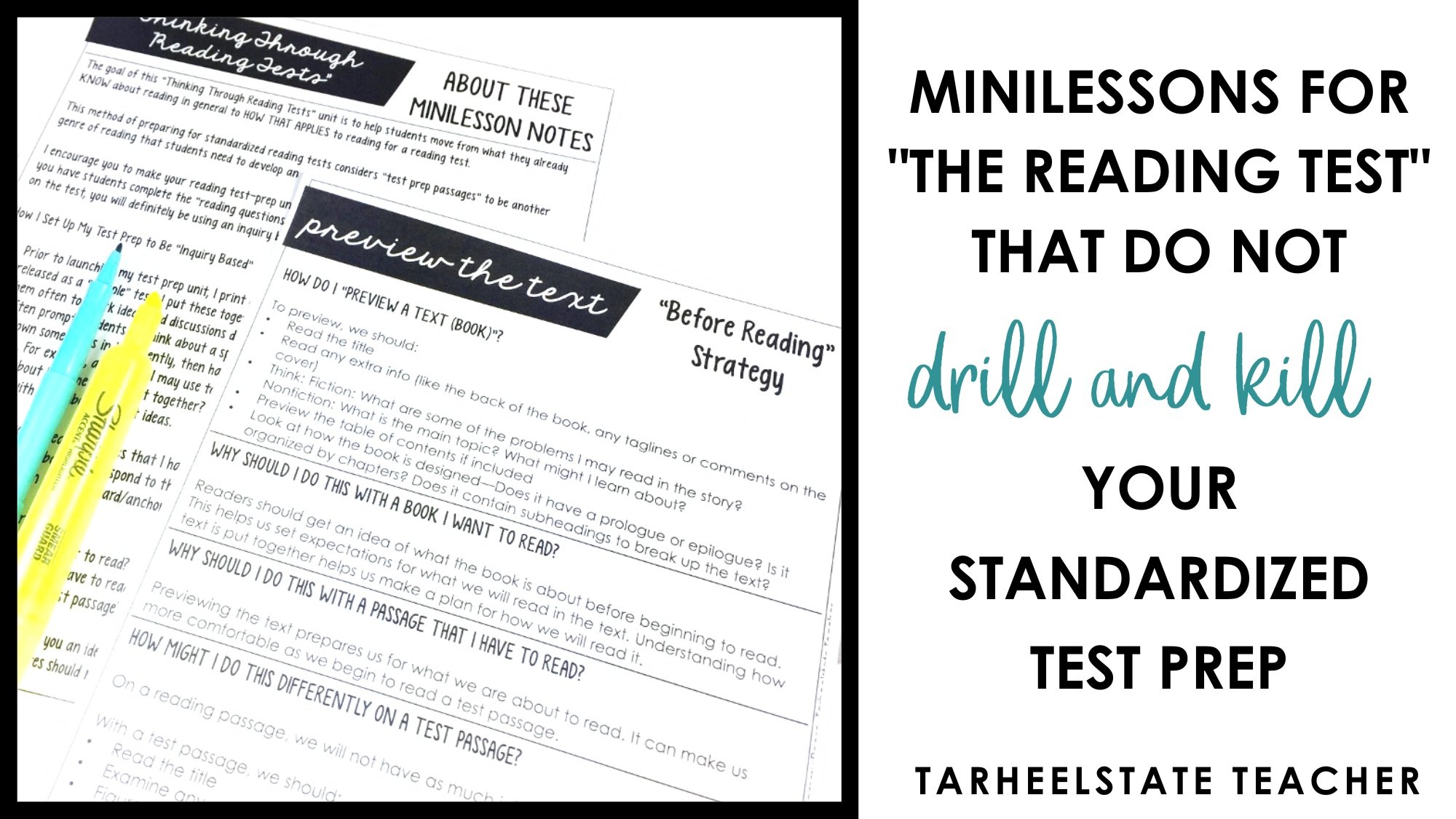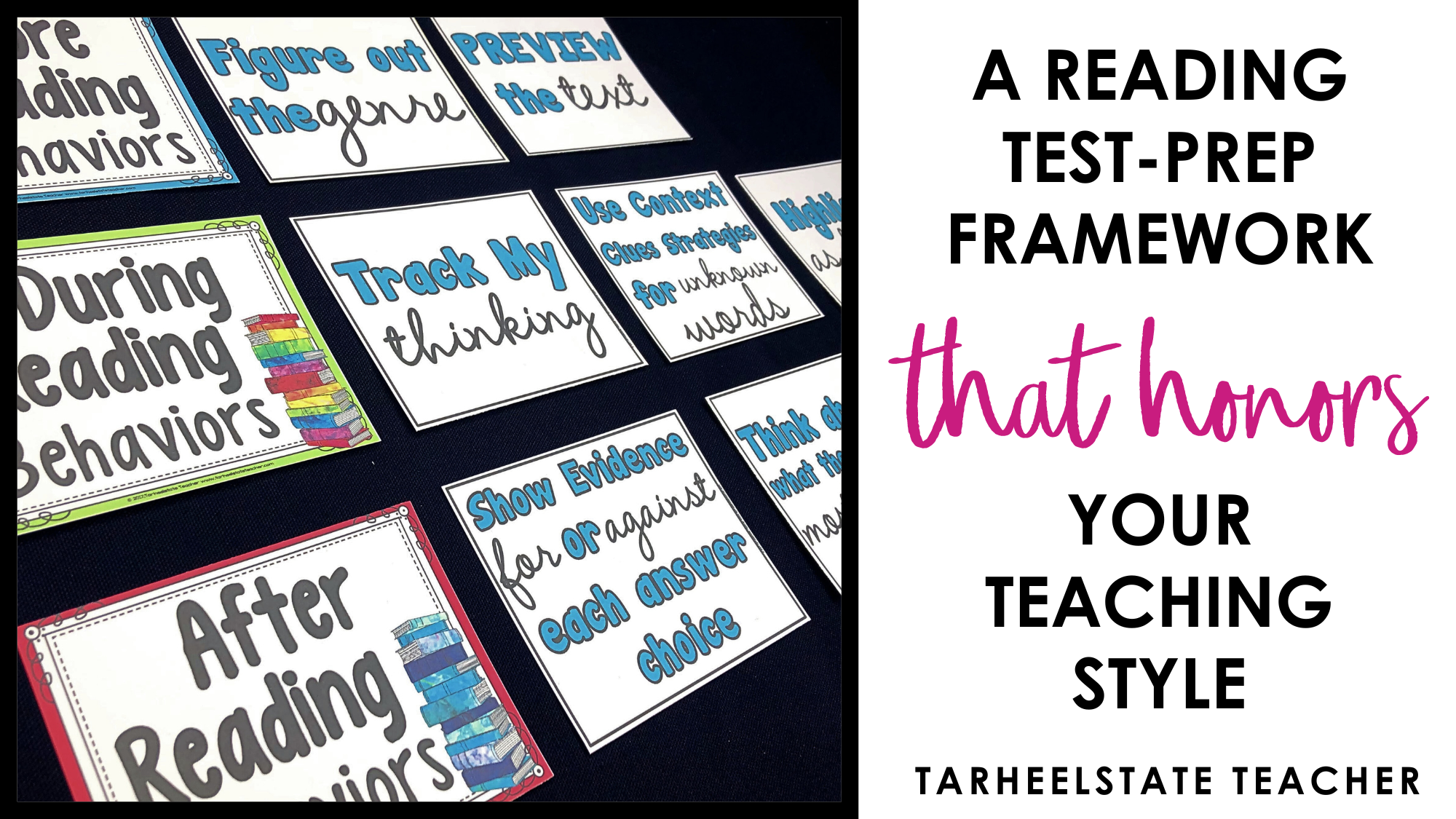Reading the Questions First as a Reading Test-Taking Strategy
Should your students be taught to read the test questions first as a test taking strategy for standardized reading tests?
I’ve written quite a bit about how I teach my students to “think through reading tests,” the 4-question framework that we use to review strategies and learn to apply them to the test, and I’ve even asked us to consider whether or not our “test-prep” attitude is broken as teachers before we even begin to launch our ELA test-taking strategies unit. Today, I want to share my perspective on a strategy that I know is often taught as a “helpful” ELA test-taking strategy—reading the related questions (and perhaps the choices) for a passage before starting to read.
First, who is this advice coming from? As a 4th and 5th grade teachers, I have prepared students for the (high-stakes) NC ELA End of Grade test for over 11 years. I’ve thought about test-taking strategies for even longer beyond those years. I’ve examined our state test in detail and even created a list of recommended places to find comparable reading passages to use when preparing your students for standardized reading tests that rely mostly on multiple-choice questions.
I wanted to write about my thoughts on teaching students to read the questions first as an ELA test-taking strategy because I know that this strategy is one that is taught. Know that I share my opinion today with love and looking out for what’s best (better) for our students.
SHOULD STUDENTS be taught to READ TEST QUESTIONS BEFORE READING A READING TEST PASSAGE?
Let’s go ahead and let the cat out of the bag…
I DO NOT encourage an entire room of 4th-grade or 5th-grade students to “read the test questions first” before beginning to read passages on a standardized reading test.
I’d like to share my reasoning for not teaching students to read the test questions first as a test-taking strategy and encourage you to consider taking on this same perspective.
In my experience, reading the questions first has often been taught as a “helpful” ELA test-taking strategy for some of our weakest readers—and for me, therein lies one of the biggest problems I have with teaching this as a test-taking strategy.
As part of my test prep lessons (and soapbox messages), I teach my students that their primary job during the standardized reading test is to COMPREHEND the PASSAGES—not to sit down and answer a bunch of test questions. I get pretty preachy about this and repeat it to them again and again in the weeks before the test as I review and introduce real strategies for comprehension that apply to the reading test.
Me: “What is your job as the reader?”
Students: “To FULLY comprehend the passage!”
When our primary job during the test is to comprehend what we read, we don’t need to place our initial focus on the questions and I believe doing so sends students the wrong message about what’s important during the testing session.
Who does this strategy serve?
Previewing questions as an ELA test-taking strategy is often taught to students who struggle with reading comprehension with the reasoning being that they will “know what they are looking for” when reading the passage. I don’t think this test-taking strategy really serves those students. I believe that teaching this strategy to students who struggle with reading comprehension is problematic for three main reasons:
Previewing the questions runs the risk of FATIGUING these students more quickly when they are working on their test passages. Students who struggle with reading will quickly tire of reading the test passages themselves—these students only have so much “gas in the tank” as they struggle with their reading fluency, ability to remember what happened in the story, and being forced to read texts above their reading level. Research shows that test performance declines the longer someone works on a test. I have seen struggling students shoot out of the gate doing an amazing job, but as the test-taking *hours* go on, their reading comprehension gets sloppier and sloppier.
BY ENCOURAGING THESE READERS TO READ ALL OF THE PASSAGE’S QUESTIONS FIRST, WE RUN THE RISK OF FURTHER DEPLETING THEIR ENERGY TANKS!Encouraging students to read the test questions first makes the test questions the main focus and priority. This SHIFTS THE FOCUS of the standardized reading test for students from COMPREHENDING what they read to ANSWERING test questions. I would rather my students spend their time and focus on applying ALL of those strategies that DO HELP US COMPREHEND.
Have you ever had a struggling reader more concerned about answering questions than comprehending what they read? These students often read in a “start and stop” manner, answering questions before they’ve fully read the text. Allowing students to make “question-answering” the main focus of their attention sets students up to read with blinders on as they are only focused on the questions being asked. Students who are overly focused on answering the test questions will most likely miss important information and have trouble making important inferences that may change the events and meaning of the story.
WHAT ABOUT OUR MORE CAPABLE READERS?
In thinking about your best readers (because I know some of us are still thinking this would be a good strategy for those students to use), they also do not need to preview all of the test questions before they begin to read.
Why? For students reading at and above grade level, their ability to work through a passage and use their strong comprehension strategies will ensure that they comprehend much of what they read and that they are able to do their best when answering test questions without needing to spend time previewing questions first.
How do I bend MY recommendation THAT STUDENTS DO NOT “READ THE TEST QUESTIONS FIRST” just a bit?
While I do not think this is a strategy that deserves my mini-lesson time, if a student is ADAMANT that reading the test questions first is a strategy he/she would like to use, I suggest that the student stick to reading just 1-2 questions before beginning to read and we come to a compromise. I am sure to explain the reasons that I do not recommend this strategy and am usually able to convince students to abandon it. However, I do keep in mind that this strategy helps SOME students calm their anxiousness (and that’s a worthy reason), but —>
Reading test questions first is not an ELA test-taking strategy that should be imposed on all students.
SO, WHAT ELA TEST-TAKING STRATEGIES SHOULD YOU TEACH INSTEAD?
You may have been trained by a mentor teacher or team member to use this strategy without being given guidance and ideas for a better way to support your students in taking a standardized reading test.
If you are looking for more guidance in preparing students for the reading test in thoughtful ways, this is a topic that I’ve written a lot about. I’d start with this list of Minilessons for Reading Test Prep and then take a look at the 4-Question Framework that is the foundation of my test-prep unit and that allows us to honor our teaching style even during test season.
🌟I’ve created an entire Reading Test Prep Unit Kit called “Thinking Through Reading Tests” designed from 11 years of experience in preparing students to take the North Carolina ELA EOG in 4th and 5th grades. It includes minilessons that help you teach students what they should do before, during, and after starting to read their test passages, anchor charts and bulletin boards to help you organize all of your minilessons, and two strategies that help students learn how to answer test questions.
You can even get the first two test-prep mini-lessons sent straight to your inbox by sharing your email below.
Click the images below to visit those blog posts and learn more!
Or, jump right in with the materials you need to launch your own “Thinking Through Reading Tests” unit. This resource includes:
♥ Test Prep Minilesson Notes (10 minilessons)
♥ Test-Prep Minilesson Bulletin Board Materials (a “Before, During, After Reading” structure for Test Taking Mini-lessons),
♥ Thinking about Question Types (to understand how to think through and answer the question): a Question-Answer-Relationship Method,
♥ Q-A-R Posters, Student Handout, and Bookmarks,
♥ a 4 Step Method for Thinking through and Answering Questions--Reword, Obviously Wrong, Collect Clues, Educated Decision (includes one model minilesson for this question/answer procedure),
♥ 4 Steps Posters and handout for students, and
♥ Test Question Sorts for 3rd-8th grades







